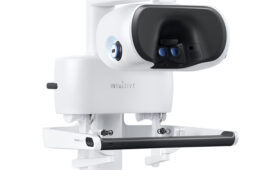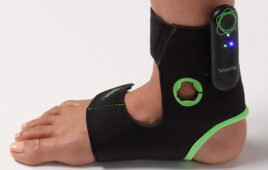In 2006, Invisible Sentinel began development of a device that would detect food-borne pathogens at the molecular level. Such molecular-level detection typically requires a laboratory and expensive equipment, not very practical for food processors striving to meet strict government food-safety standards. When in development, the Veriflow device showed it could provide molecular-level detection of pathogens in a convenient, economical, hand-held device that did not require a team of scientists to administer. The company needed a manufacturing process to ensure consistent product quality and performance.

The 2000x-d assembly system maintains optimum melt-collapse distance to ensure repeatable ultrasonic welds.
First, the new device had to demonstrate to the Association of Analytical Communities that it could safely, accurately, and consistently detect molecular food-borne pathogen signatures. That meant its internal testing technology had to be 100 % protected against outside contamination. That required joining the two halves of its high-impact polystyrene housing with a highly-repeatable process that would produce a hermetic weld joint that could withstand significant pressure created by the device’s internal processes, while also avoiding damage to its delicate internal mechanisms with varying melt indexes.
The company brought Branson into a collaborative partnership in the early stages of product design. “Invisible Sentinel understood how our process-neutral approach to assessing the challenge would produce the best-process recommendation, and how our global capabilities would support them as they expand their markets for Veriflow around the world,” said Bob Jalbert, Branson District Sales Engineer. The partners agreed that ultrasonic welding was the right course, and chose the Branson 2000X-d ultrasonic assembly system for the task.
Branson engineers went to work defining the horn and nest parameters using finite-element analysis, at times convening with the customer in Branson’s Connecticut development lab to refine the details. The team collaborated on design of experiments to determine best process windows using force, triggers, and distance settings to maximize energy and efficiency for the welds.
The 2000X-d is a user-friendly, digital system that allows dialing in process parameters and control limits easily through a touch screen interface. And its S-beam load cell and optical linear encoder provide precise feedback and control. The system maintains optimum melt-collapse distances that meet the requirement for repeatable welds within a 0.001 to 0.002 in. tolerance. In addition, the 2000X-d’s monitoring capabilities will detect variations inside the device to maintain consistent, tight-tolerance welds, while protecting the delicate interior test mechanisms. Branson ensured the precise process parameters and once the team agreed they had a final solution, the company also provided a loaner machine so Invisible Sentinel could quickly begin producing units.
The company is now manufacturing over 1,000 units daily, and anticipates an eight-fold growth in the near term to serve an expanding global demand. Branson’s expertise and collaborative spirit also resulted in Invisible Sentinel achieving AOAC approval and subsequent FDA recognition. Another plus: Invisible Sentinel was able to launch the Veriflow device sooner than would have been otherwise possible. “With the completion of our new state-of-the-art production facility, we’ve been able to significantly increase our production volume. The team at Branson has worked with us continually to ensure that as we’ve increased capacity, our quality not only remained constant, but improved.”
Branson Ultrasonics
www.bransonultrasonics.com


![A photo of the Medtronic GI Genius ColonPro polyp detection system flagging a potential sign of colon cancer during a colonoscopy. [Photo courtesy of Medtronic]](https://www.medicaldesignandoutsourcing.com/wp-content/uploads/2024/04/Medtronic-GI-Genius-doctors-268x170.jpg)

